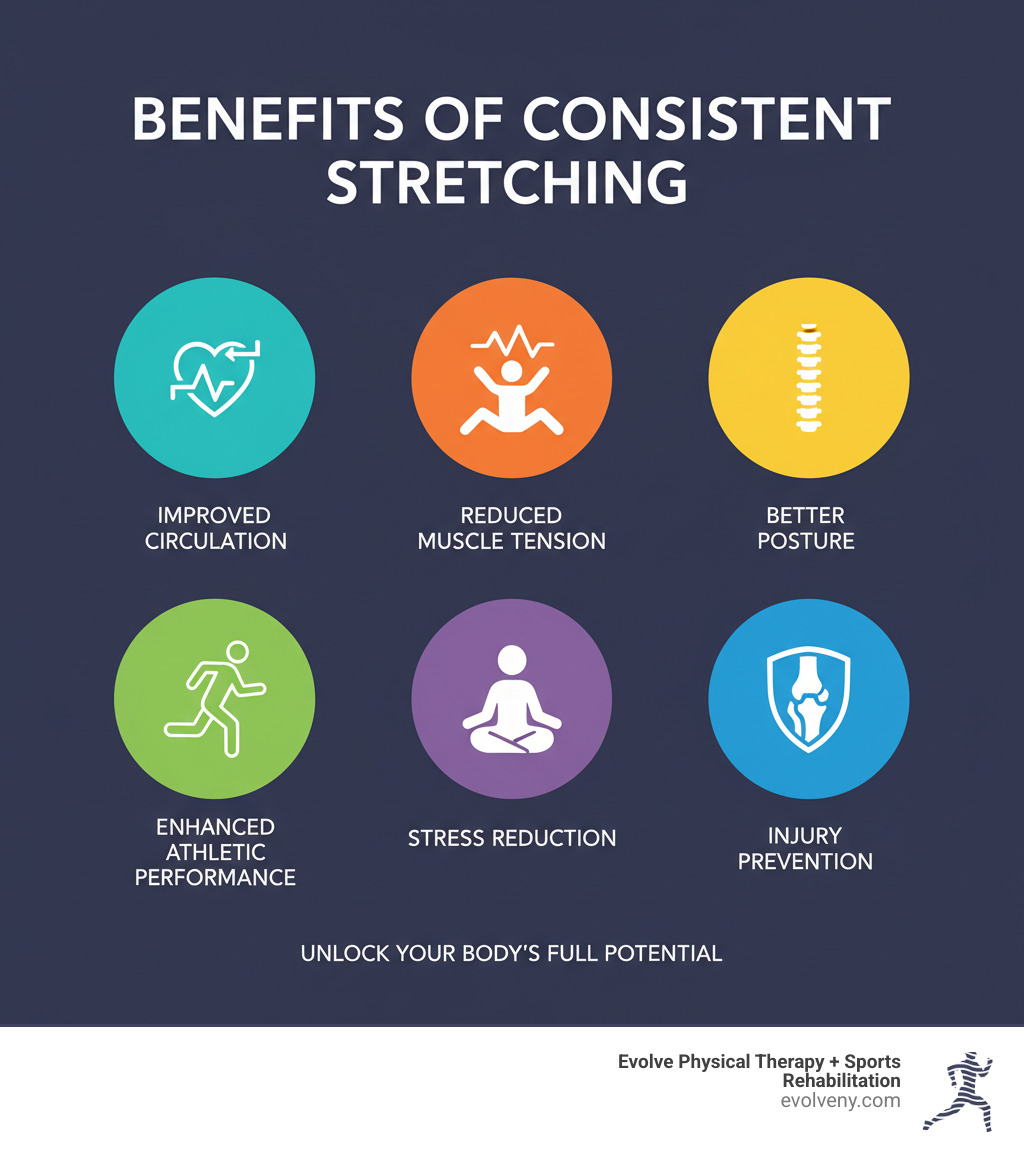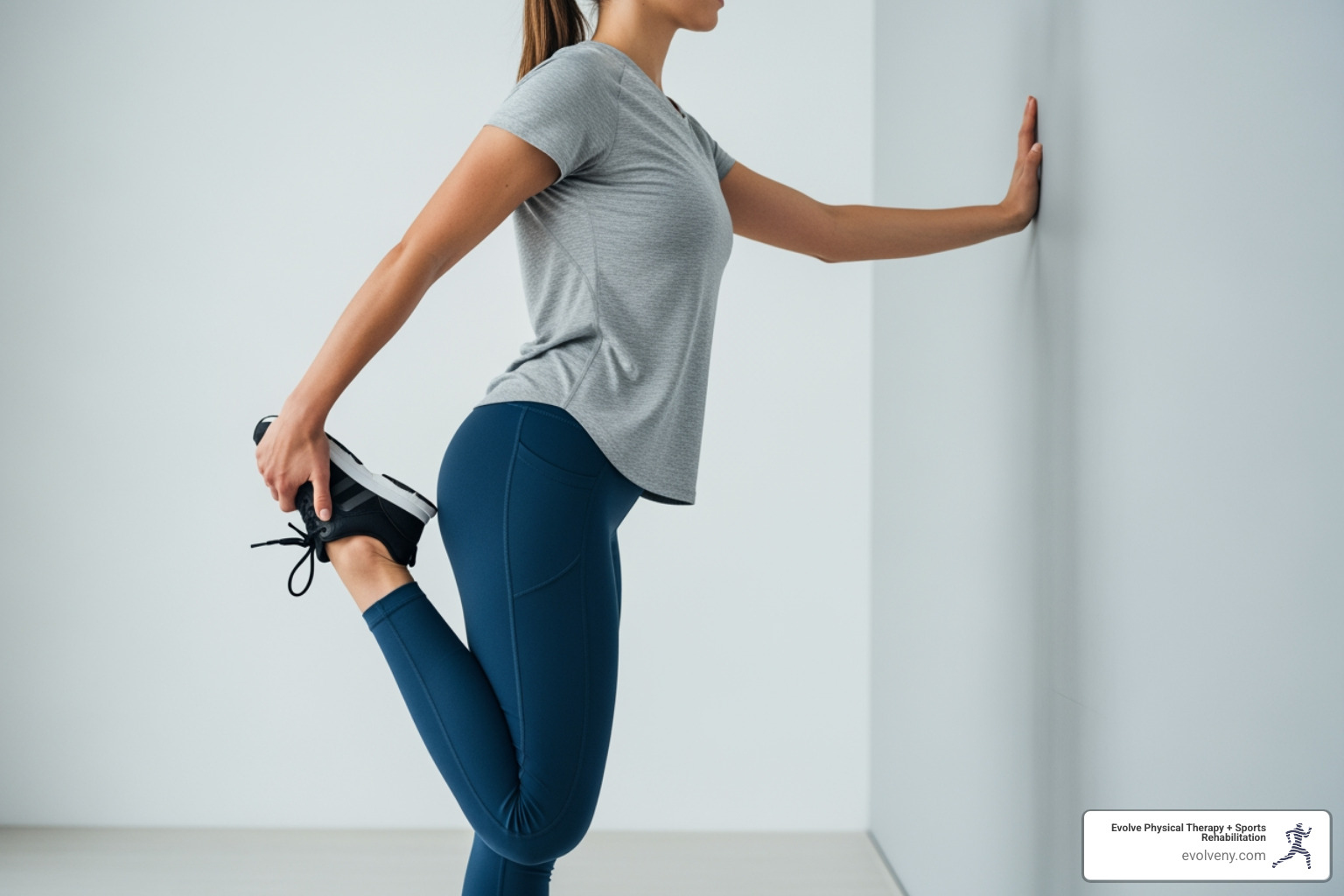Beyond the Stretch: How Manual Exercises Transform Your Body
Why Manual Stretching Exercises Matter for Your Body

Manual stretching exercises are movements where you deliberately lengthen muscles to improve flexibility and range of motion. When done correctly, they offer significant benefits:
- Increased Flexibility & Range of Motion: Move more freely in daily activities.
- Injury Prevention: Reduce strain risk by strengthening muscle-tendon connections.
- Pain Relief: Ease chronic discomfort in the back, neck, and joints.
- Better Posture: Correct muscle imbalances caused by prolonged sitting.
Many active adults struggle with recurring pain despite staying fit. Traditional advice often suggests rest or surgery, but this overlooks the root cause: tight, shortened tissues pulling the body out of alignment. Manual stretching exercises target these imbalances directly.
Research confirms that consistent stretching improves flexibility, reduces injury risk, and helps manage conditions like back pain. Holding a stretch for 30 seconds, repeated several times, can significantly improve your range of motion. However, the type of stretching matters. Static stretching (holding a position) is best for general flexibility, while dynamic stretching (controlled movements) prepares your body for exercise.
I'm Lou Ezrick, founder of Evolve Physical Therapy in Brooklyn. For nearly two decades, I've helped thousands of patients overcome chronic pain with targeted manual stretching exercises and hands-on rehabilitation. I've seen how the right program can transform not just movement, but a person's entire quality of life.

The Science of the Stretch: How Your Muscles Adapt
When you perform manual stretching exercises, you're triggering a conversation between your muscles and your nervous system. Consistent stretching literally lengthens your muscles over time by adding new units called sarcomeres. It also remodels the connective tissue (fascia) that wraps your muscles, making it more pliable.
Your nervous system has built-in safety mechanisms. Muscle spindles detect when a muscle stretches too fast or too far, triggering a protective stretch reflex that causes it to contract. This is why bouncing during a stretch is counterproductive. Conversely, Golgi Tendon Organs (GTOs) monitor tension; when it's high, they signal the muscle to relax. This allows for a deeper, safer stretch.
Through consistent manual stretching exercises, you can retrain these reflexes, teaching your nervous system to allow a greater range of motion. You're not forcing change; you're working with your body's natural systems. For a deeper dive, see these current concepts in muscle stretching for exercise and rehabilitation.
Static vs. Dynamic Stretching: What's the Difference?
Timing and technique are crucial for effective manual stretching exercises. The two main types are static and dynamic.
Static stretching is when you hold a stretch in a still position, typically for 15-60 seconds. It's best performed after a workout as part of your cool-down. This helps improve long-term flexibility, increase range of motion, and relax your muscles.
Dynamic stretching involves controlled, fluid movements that take your joints through their full range, like leg swings or arm circles. It's the ideal warm-up before exercise, as it increases blood flow, raises body temperature, and prepares your neuromuscular system for activity.
| Feature | Static Stretching | Dynamic Stretching |
|---|---|---|
| Purpose | Increase flexibility, improve ROM, cool-down | Warm-up, prepare for activity, improve mobility |
| Movement | Held position, no bouncing | Controlled, fluid movements, repetitive |
| Timing | After workout/activity | Before workout/activity |
| Examples | Hamstring stretch, calf stretch, triceps stretch | Leg swings, arm circles, torso twists |
| Primary Benefit | Long-term flexibility gains, muscle relaxation | Improved performance, improved blood flow |
A simple rule: use dynamic stretches to prepare for movement and static stretches to cool down afterward. Avoid ballistic stretching (bouncing), which can trigger the stretch reflex and increase injury risk.
Advanced Stretching Techniques
For those ready to advance, Proprioceptive Neuromuscular Facilitation (PNF) is a powerful technique. PNF combines passive stretching with muscle contractions to achieve rapid gains in flexibility. It leverages the GTO reflex to trick the muscle into relaxing more deeply.
One common method is the hold-relax technique. A partner stretches your muscle to a comfortable limit. You then isometrically contract that muscle against their resistance for 5-10 seconds. Upon relaxing, your partner can guide you into a deeper stretch. PNF often produces more immediate gains in range of motion than static stretching alone.
Because PNF is a form of assisted stretching and is quite intense, it's best performed with a qualified professional. At Evolve Physical Therapy, we use PNF to help patients restore joint mobility quickly and safely.
The Ultimate Guide to Safe and Effective Manual Stretching Exercises
To get the most from manual stretching exercises, safety is paramount. Following a few key guidelines ensures you're helping your body, not harming it.
The most important rule is that stretching should never hurt. You should feel a gentle pull or mild tension, not sharp pain. Pain is a signal to stop. Always warm up for 5-10 minutes with light cardio before stretching to prepare your muscles. Never bounce your stretches; this can trigger a protective muscle contraction and increase injury risk. Instead, move slowly and deliberately.
Avoid stretching if you have an acute injury, active inflammation, or feel sharp pain during movement. People with hypermobility, unhealed fractures, or bony blocks that limit movement should also be cautious and seek professional guidance. For more on safe stretching, see these current concepts in muscle stretching for exercise and rehabilitation.
The Golden Rules: Duration, Frequency, and Breathing
To see real results from manual stretching exercises, follow these three golden rules:
- Duration: Hold static stretches for 15-30 seconds. For deeper, more lasting changes, you can work up to 60 seconds. Perform 2-4 repetitions for each stretch.
- Frequency: Consistency is key. Stretch your major muscle groups at least 2-3 days per week to see and maintain improvements in flexibility.
- Breathing: Never hold your breath. Breathe slowly and rhythmically. Try to relax deeper into the stretch with each exhalation to reduce tension and increase effectiveness.
Getting Started with Basic Manual Stretching Exercises
These foundational manual stretching exercises target common areas of tightness in the lower body.
- Hamstring Stretch: Lie on your back and loop a towel under the ball of one foot. Gently straighten that leg toward the ceiling, pulling the towel to feel a stretch in the back of your thigh. Hold for 15-30 seconds.
- Quadriceps Stretch: Standing, use a wall for balance. Grab your ankle and gently pull your heel toward your buttock, feeling a stretch in the front of your thigh. Hold for 15-30 seconds.
- Calf Stretch: Face a wall, step one foot back, and keep the back leg straight with the heel on the floor. Lean forward until you feel a stretch in your calf. Hold for 15-30 seconds.
- Groin Stretch (Butterfly): Sit on the floor with the soles of your feet together. Gently press your knees toward the floor to stretch your inner thighs. Hold for 15-30 seconds.

For more ideas, check out this guide to basic stretches from the Mayo Clinic.
Targeting Key Areas: Neck, Shoulders, and Back
Combat the tension from desk work and daily stress with these upper body manual stretching exercises.
- Side Bend Neck Stretch: Sit tall and gently tilt your ear toward your shoulder. Hold for 15-30 seconds and repeat on the other side.
- Cross-Body Shoulder Stretch: Pull one arm across your chest with your opposite hand, keeping the shoulder down. Hold for 15-30 seconds, then switch arms.
- Doorway Chest Stretch: Stand in a doorway with forearms on the frame. Step forward and lean in to feel a stretch across your chest. Hold for 20-30 seconds.
- Knee-to-Chest Stretch: Lie on your back and gently pull one knee toward your chest to stretch your lower back. Hold for 15-30 seconds and repeat with the other leg.
- Seated Trunk Rotation: Sitting in a chair, twist your upper body to one side, using the chair for a gentle assist. Hold for 10-20 seconds, then switch sides.

Always ease into these stretches gently and listen to your body. Regular practice will bring significant relief and improved mobility.
Integrating Stretching into Your Life
Manual stretching exercises are about more than flexibility; they're about creating a life with easier movement, less pain, and reduced stress. Approaching stretching mindfully, by focusing on your breath and body sensations, can calm your nervous system and break the cycle of stress-induced muscle tension.
Regular stretching makes everyday movements feel effortless and helps protect against injury, which is especially important as we age. For those with chronic conditions like osteoarthritis, it's a powerful tool for managing discomfort. The key is consistency and gradual progression.
Stretching for Your Lifestyle: Warm-ups, Cool-downs, and Desk Breaks
Manual stretching exercises can be integrated into any lifestyle. Small, strategic moments of stretching create meaningful change.
- Warm-ups: Before exercise, perform 5-10 minutes of dynamic stretching (e.g., arm circles, leg swings). This prepares your body for action by increasing blood flow and muscle temperature.
- Cool-downs: After your workout, use static stretching. Holding stretches for 15-30 seconds while your muscles are warm improves long-term flexibility and can reduce soreness.
- Desk Breaks: If you sit for long periods, take short stretch breaks every hour. Try these simple stretches at your desk:
- Neck: Slowly turn your head to look over each shoulder, holding for 10-30 seconds.
- Wrists: Extend one arm and gently pull your fingers down, then up. Repeat on the other side.
- Chest: Interlace your fingers behind your head and squeeze your shoulder blades together to open your chest.
How to Progress with Manual Stretching Exercises
As you become more flexible, your manual stretching exercises will feel easier. To continue making progress, you can:
- Increase duration: Gradually work up from holding stretches for 30 seconds to 60 seconds.
- Go deeper: As a muscle relaxes, gently ease further into the stretch without causing pain.
- Add variety: Incorporate new stretches or use props like a strap or foam roller.
- Try advanced techniques: When ready, consider PNF stretching with a professional to accelerate flexibility gains.
Progression should always be gradual and pain-free. Consistency is more important than intensity for building lasting flexibility.
Frequently Asked Questions about Manual Stretching
Here are answers to the most common questions we hear about manual stretching exercises at our Brooklyn physical therapy clinic.
Should stretching hurt?
No. Stretching should never cause sharp pain. The "no pain, no gain" myth is dangerous when it comes to stretching. You should feel a gentle pull or mild tension in the muscle, which indicates it is lengthening effectively. Sharp pain is your body's signal to stop, as it can mean you are triggering a protective muscle contraction or causing damage. Always listen to your body and ease off if you feel pain.
How long does it take to see flexibility improvements?
This varies for everyone, depending on factors like age, genetics, and starting flexibility. However, with a consistent routine of manual stretching exercises (2-3 times per week), most people notice measurable improvements in their range of motion within 2 to 4 weeks. More significant, long-lasting changes typically take several months of dedicated practice. The most important factor is consistency; regular, short sessions are more effective than infrequent, long ones.
Is it better to stretch before or after a workout?
Both, but the type of stretching is different.
- Before a workout: Use dynamic stretching (e.g., leg swings, arm circles) as part of your warm-up. These active movements increase blood flow and prepare your muscles for activity, improving performance and reducing injury risk.
- After a workout: Use static stretching (holding a stretch for 15-60 seconds) as part of your cool-down. Your muscles are warm and pliable, making this the ideal time to improve long-term flexibility and range of motion.
Conclusion: Transform Your Movement, Transform Your Life
You now have the knowledge to use manual stretching exercises to improve flexibility, reduce pain, and prevent injuries. The key is to put this knowledge into action. Committing to a consistent routine, even for just a few minutes a week, will be rewarded with greater mobility and an improved quality of life.
Many people, like the patient with sciatic pain mentioned earlier, have avoided invasive procedures by addressing the root cause of their pain through targeted stretching and physical therapy. This is the power of a proactive, hands-on approach.
At Evolve Physical Therapy, we help people across Brooklyn—from Marine Park to Park Slope—find their body's potential. Our hands-on method involves a unique evaluation, expert guidance on proper technique, and a personalized program that adapts as you progress. We address the underlying imbalances, not just the symptoms.
If you're ready to move with more ease and confidence, we're here to help. Learn how our personalized manual stretching exercises and hands-on therapy can make a difference. Find out more at our manual physical therapy services page.
Your body has carried you this far. Let's help it carry you even further.

